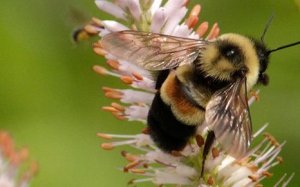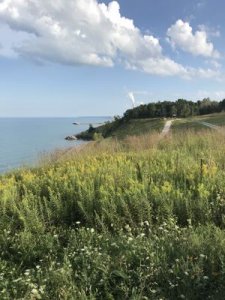Buzzing with Excitement for Native Pollinators
 Milwaukee has recently been the stage to some surprising animal stars. From the return of the river otter to the first downtown beaver spotting in nearly two centuries, Milwaukee’s conservation stewards are seeing the furry fruits of their labor everywhere. But there’s another comeback kid, and it might be buzzing right under your nose.
Milwaukee has recently been the stage to some surprising animal stars. From the return of the river otter to the first downtown beaver spotting in nearly two centuries, Milwaukee’s conservation stewards are seeing the furry fruits of their labor everywhere. But there’s another comeback kid, and it might be buzzing right under your nose.
The critically endangered rusty patched bumble bee (Bombus affinis) once thrived in the woodlands and oak savannas of Southeastern Wisconsin, but has seen an 87% decline in the last 20 years primarily due to habitat loss and fragmentation. While this pollinator is currently found in only 0.1% of its historical range, thanks to the tireless work of the Milwaukee County Parks, Recreation, & Culture Department, they may be making a homecoming flight.
Natural Areas Coordinator Brian Russart and his team have helped restore 9,000 acres of habitat throughout the County, creating and maintaining safe and stable ecosystems for vulnerable and endangered species like the rusty patched bumble bee.
“We have an important responsibility to both manage parkland for the citizens of Milwaukee County, and to make  smart and progressive conservation decisions for the millions and millions of native plants and animals that call our park system home,” says Russart, a lifelong outdoor enthusiast with a family history rich in stewardship in the Milwaukee River watershed.
smart and progressive conservation decisions for the millions and millions of native plants and animals that call our park system home,” says Russart, a lifelong outdoor enthusiast with a family history rich in stewardship in the Milwaukee River watershed.
Support from the Fund for Lake Michigan helped create a 48-acre prairie planting at Bender Park and, more recently, a pollinator garden at Greenfield Park. Executive Director Vicki Elkin has been one of many eagerly following the progress of these pollinators and the parks that play host.
“The Fund’s grants aim to improve water quality, but it’s always exciting to support projects that amount to even more. Milwaukee County’s restoration projects continue to uncover more benefits for our watershed, its species, and for our community year after year, “ says Elkin.
Greenfield Park is one of six County parks that have recently hosted rusty patched bumble bees and several other bumble bee species considered “Species of Greatest Conservation Need” by the Wisconsin Department of Natural Resources.
The successful return of these species can have cascading effects on Milwaukee’s ecology and significant benefits in local food systems, as research shows native pollinators to be 2-3 times more efficient than non-native honeybees. Russart says he’s optimistic that conserving the rusty patched bumble bee will help increase awareness and support of native pollinators.
“For species like the rusty patched bumble bee, extinctions happen locally before they happen globally, making local conservation efforts vital in protecting rare species,” said Russart.
The Milwaukee County Natural Areas Staff have exemplified that commitment to thinking globally and acting locally, partnering with countless community volunteers from an astonishing 87 organizations over the last five years including the U.S. Forest Service, Hawley Environmental School, the University of Wisconsin—Milwaukee.
The Milwaukee County conservationists will continue to monitor these sites to better understand the species’ decline and evaluate the success of their conservation strategies. This year, the Milwaukee County Parks department is excited to introduce a new community bumble bee survey. Training for the program will take place in May.
You can get involved by joining in on the survey or volunteering at the pollinator gardens in Juneau, Grant, and Greenfield Park. Contact Assistant Natural Areas Coordinator Emilie Hunn at for more information.